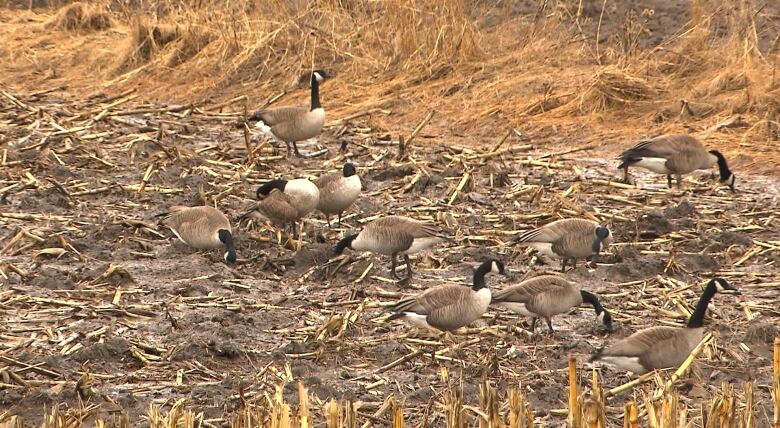Professional scarecrows watch over Quebec's fields as spring migration begins
Provinces agricultural producers union hires about 100 people a year to scare off returning birds
Their honks may announce the return of spring, but not everyone welcomes back the hundreds of thousands of migrating geese that appear alongside the warmer weather.
For Quebec's farmers the return of geese means damaged fields as the birds lay waste to the open ground, scavenging for food.
But farmers have one ace up their sleeves for that time of year when the birds return: the professional scarecrow.
Armed with a gun that firesblank cartridges, these prosscare the geese offproperties in hopes of limiting the damage.
"If there are birds in a field, I take out the gun and get rid of them," said Yvon Berthiaume, who is retired but works as a scarecrow around theMontrgieregion, just south of Montreal, during the migration season.
"They go somewhere else, and we go somewhere else. I change places every day."
The province's agricultural producers union hires about 100 professional scarecrows to watch over fields across Quebec each year.

Fields an open-air pantry to be raided
More than 1.8 million migrating birds travel along the St. Lawrence corridor up until the end of May.
Many of the birds, including snow and Canada geese, eat corn stalks and sprouts of alfalfa or hay. They can destroy up to 20 per cent of the first harvest and cause producers to lose tens of thousands of dollars.
"They eat everything, all of the plants that are coming out. It's devastating," said farmer Andr Lussier, adding the longer the birds stay, the worse the damage.
Since 2003 the provincial and federal governments have helped finance the program that pays for the professional scarecrows. Before the program began, fields were almost an open-air pantry waiting to be raided by passing geese.
"It's much easier to get food from farmland than to graze in the marsh, where they consume bulrushes in the mud," said Jean-Franois Giroux, a biologist and director of the biology department at theUniversit du Quebec Montral.
Giroux said the energy-rich food the geese find in farmer's fields has contributed to their growing population. For snow geese,it gives them a higher chance of success to make their trip tothe arctictolay eggs.

Spreading out the damage
While the professional scarecrows don't solve the problem, some believe they can make a big difference for farmers.
"Instead of eating for two hours in the same field and causing a lot of damage, they can eat maybe for an hour in the first field and another hour in a second field, then the damage is less serious in each field," said Giroux.
Professional scarecrows expect tobe busy this spring.
Standing just outside a field after firing a blank shot, Berthiaume watches a group of Canada geese fly off and out of view.
"They may come back tomorrow. Me too."
With files from Radio-Canada's Annie Hudon-Friceau













_(720p).jpg)


 OFFICIAL HD MUSIC VIDEO.jpg)
.jpg)



























































































